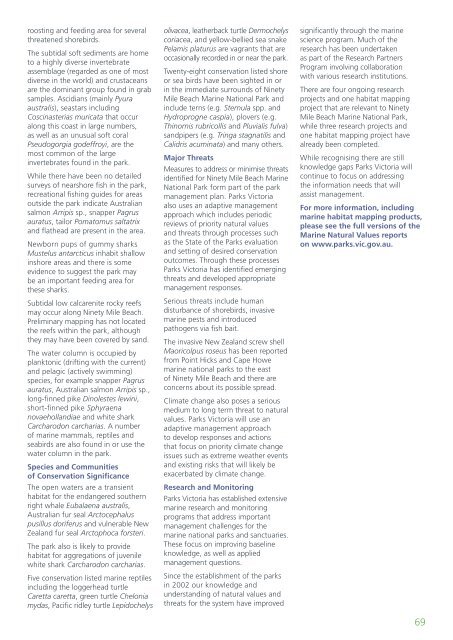Marine Natural Values Study Summary - Parks Victoria
Marine Natural Values Study Summary - Parks Victoria
Marine Natural Values Study Summary - Parks Victoria
You also want an ePaper? Increase the reach of your titles
YUMPU automatically turns print PDFs into web optimized ePapers that Google loves.
oosting and feeding area for severalthreatened shorebirds.The subtidal soft sediments are hometo a highly diverse invertebrateassemblage (regarded as one of mostdiverse in the world) and crustaceansare the dominant group found in grabsamples. Ascidians (mainly Pyuraaustralis), seastars includingCoscinasterias muricata that occuralong this coast in large numbers,as well as an unusual soft coralPseudogorgia godeffroyi, are themost common of the largeinvertebrates found in the park.While there have been no detailedsurveys of nearshore fish in the park,recreational fishing guides for areasoutside the park indicate Australiansalmon Arripis sp., snapper Pagrusauratus, tailor Pomatomus saltatrixand flathead are present in the area.Newborn pups of gummy sharksMustelus antarcticus inhabit shallowinshore areas and there is someevidence to suggest the park maybe an important feeding area forthese sharks.Subtidal low calcarenite rocky reefsmay occur along Ninety Mile Beach.Preliminary mapping has not locatedthe reefs within the park, althoughthey may have been covered by sand.The water column is occupied byplanktonic (drifting with the current)and pelagic (actively swimming)species, for example snapper Pagrusauratus, Australian salmon Arripis sp.,long-finned pike Dinolestes lewini,short-finned pike Sphyraenanovaehollandiae and white sharkCarcharodon carcharias. A numberof marine mammals, reptiles andseabirds are also found in or use thewater column in the park.Species and Communitiesof Conservation SignificanceThe open waters are a transienthabitat for the endangered southernright whale Eubalaena australis,Australian fur seal Arctocephaluspusillus doriferus and vulnerable NewZealand fur seal Arctophoca forsteri.The park also is likely to providehabitat for aggregations of juvenilewhite shark Carcharodon carcharias.Five conservation listed marine reptilesincluding the loggerhead turtleCaretta caretta, green turtle Cheloniamydas, Pacific ridley turtle Lepidochelysolivacea, leatherback turtle Dermochelyscoriacea, and yellow-bellied sea snakePelamis platurus are vagrants that areoccasionally recorded in or near the park.Twenty-eight conservation listed shoreor sea birds have been sighted in orin the immediate surrounds of NinetyMile Beach <strong>Marine</strong> National Park andinclude terns (e.g. Sternula spp. andHydroprogne caspia), plovers (e.g.Thinornis rubricollis and Pluvialis fulva)sandpipers (e.g. Tringa stagnatilis andCalidris acuminata) and many others.Major ThreatsMeasures to address or minimise threatsidentified for Ninety Mile Beach <strong>Marine</strong>National Park form part of the parkmanagement plan. <strong>Parks</strong> <strong>Victoria</strong>also uses an adaptive managementapproach which includes periodicreviews of priority natural valuesand threats through processes suchas the State of the <strong>Parks</strong> evaluationand setting of desired conservationoutcomes. Through these processes<strong>Parks</strong> <strong>Victoria</strong> has identified emergingthreats and developed appropriatemanagement responses.Serious threats include humandisturbance of shorebirds, invasivemarine pests and introducedpathogens via fish bait.The invasive New Zealand screw shellMaoricolpus roseus has been reportedfrom Point Hicks and Cape Howemarine national parks to the eastof Ninety Mile Beach and there areconcerns about its possible spread.Climate change also poses a seriousmedium to long term threat to naturalvalues. <strong>Parks</strong> <strong>Victoria</strong> will use anadaptive management approachto develop responses and actionsthat focus on priority climate changeissues such as extreme weather eventsand existing risks that will likely beexacerbated by climate change.Research and Monitoring<strong>Parks</strong> <strong>Victoria</strong> has established extensivemarine research and monitoringprograms that address importantmanagement challenges for themarine national parks and sanctuaries.These focus on improving baselineknowledge, as well as appliedmanagement questions.Since the establishment of the parksin 2002 our knowledge andunderstanding of natural values andthreats for the system have improvedsignificantly through the marinescience program. Much of theresearch has been undertakenas part of the Research PartnersProgram involving collaborationwith various research institutions.There are four ongoing researchprojects and one habitat mappingproject that are relevant to NinetyMile Beach <strong>Marine</strong> National Park,while three research projects andone habitat mapping project havealready been completed.While recognising there are stillknowledge gaps <strong>Parks</strong> <strong>Victoria</strong> willcontinue to focus on addressingthe information needs that willassist management.For more information, includingmarine habitat mapping products,please see the full versions of the<strong>Marine</strong> <strong>Natural</strong> <strong>Values</strong> reportson www.parks.vic.gov.au.69
















